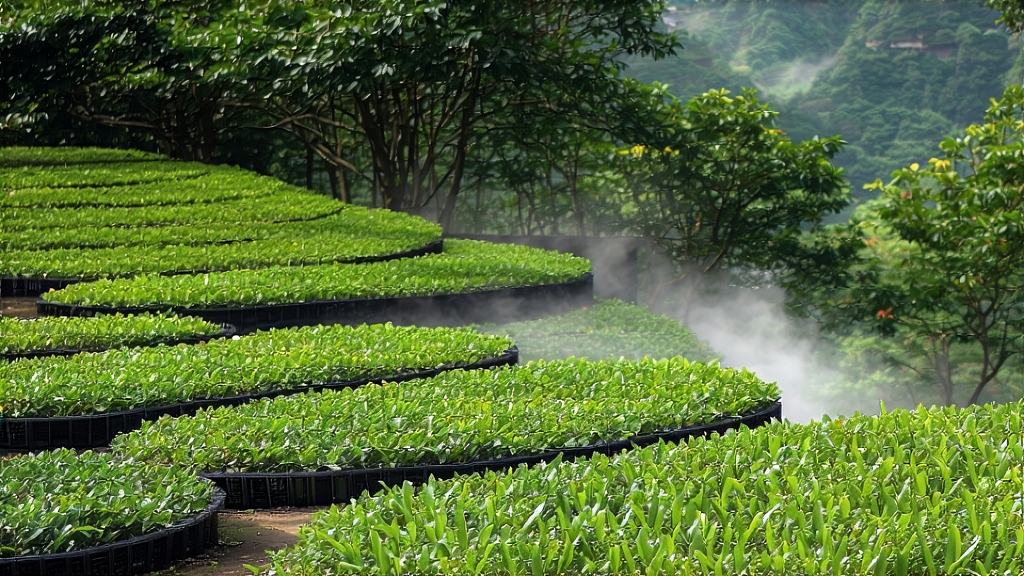
Few leaves carry as much poetry in their veins as Tie Guan Yin, the “Iron Goddess of Mercy.” Born in the granite ridges of Anxi, Fujian, this oolong has moved from secluded temple gardens to the cups of emperors, merchants, and, today, curious tea lovers on every continent. Yet its heart still beats to the slow rhythm of mountain mist, charcoal embers, and the calloused hands of generations who refuse to let the craft slip into mere factory routine.
History: From Altar to Auction Block
Legend places Tie Guan Yin’s birth in the 18th century. A devout farmer named Wei Yin, so the story goes, found a weather-worn iron statue of Guan Yin, the Bodhisattva of Compassion, abandoned in a cliff-side grotto. He carried it home, cleaned it, and burned incense daily. One night the goddess appeared in a dream, pointing him to a cave behind his hut where a single tea shrub shimmered in moonlight. Wei transplanted it, nurtured it, and the tea it yielded carried an aroma so haunting that neighbors swore it bore the breath of the divine. Whether myth or marketing, the tale cemented the tea’s spiritual aura; even today, the finest lots are first offered to the goddess before they reach market.
Imperial patronage soon followed. Qing court records from 1738 mention “Anxi Guan Yin” among tributes sent northward on mule caravans. By the late 19th century, Tie Guan Yin had slipped down the Min River to the treaty port of Xiamen, sailed past the Cape of Good Hope, and graced London salons where it was marketed as “Iron Buddha” to capitalize on Victorian orientalism. Global fame waxed and waned—war, revolution, and planned economies nearly erased artisanal knowledge—yet the 1980s economic thaw revived ancient gardens, and today Anxi County alone boasts 600 square kilometers of Tie Guan Yin bushes.
Varieties: One Name, Many Faces
Tie Guan Yin is not a single tea but a spectrum of styles governed by cultivar, season, and, above all, the maker’s intent. Purists recognize three pillars:
- Traditional Tie Guan Yin (Chuan Tong) – 30–40 % oxidation, charcoal baked in bamboo baskets over lychee-wood embers for 30–60 hours. The leaf is dull jade, the liquor deep amber, the flavor a layered triad of honeyed orchid, toasted sesame, and cooling camphor that lingers in the throat as yun gan, literally “rhythm of sweetness.”
- Modern Green Tie Guan Yin (Qing Xiang) – 15–20 % oxidation, little or no baking. Electric dryers lock in a spring-green leaf that brews pale gold; the cup bursts with snap-pea freshness, lily bouquet, and a silky creaminess reminiscent of fresh coconut water.
- “Cream” or Nai Xiang styles – a post-2000 innovation where leaves are lightly steamed with tiny amounts of rice-milk vapor, adding a custard note without violating China’s ban on foreign aromatics.
Seasonality further refines identity. Spring tea (Gu Chun) harvested around Grain Rain offers the most complex aromatics; autumn tea (Qiu Xiang) trades delicacy for a thicker body and headier perfume. Summer and winter harvests exist but rarely leave the county, used mostly for blending or milk-tea bases.
Craft: The Choreography of Leaf and Fire
Making Tie Guan Yin is a 24-hour marathon that begins at dawn when dew still pearls the leaf. Pickers pluck only the open leaf-and-bud “fish-leaf” set, rejecting older blades to keep astringency low. The baskets must reach the village workshop within two hours; any delay starts uncontrolled red-edge oxidation that dulls fragrance.
Withering happens in two acts: first under natural sunlight for 10–20 minutes, then on woven bamboo racks indoors where large fans lower leaf temperature to 22 °C. When the leaf feels as supple as glove leather, tumbling begins. In a giant bamboo drum rotating at 30 rpm, edges bruise against ridges, triggering enzymatic browning while veins stay green—the hallmark “green heart, red edge” of oolong. This step is repeated six to eight times across four hours, each interval longer, each rotation gentler, coaxing floral precursors to concentrate.
Fixation halts oxidation at the desired point. A 230 °C wok, heated by